|
|
Post by satamax on Jan 30, 2013 22:36:00 GMT -8
Hi guys.
Well, in Mhkhankan thread, Donkey's wondering what an eight incher horizontal can do. Lately, i'm along the same lines. Kind of. I'm wondering if it would be possible to make a rocket fireplace. I mean something wider than high. Not too deep. Open on the whole front. Let say 60cm high, 60cm deep, and may be 80cm wide. That box made out of bricks i think. Insulated outside, just for the sake of it. Then on top of the box i hesitate, either cone or pyramid shape, insulated, thought i'm not that sure that would be good. I think it would be better to make the box ceiling flat, with a hole in the middle, above the fire, and put a heat riser there. Thought, i wonder, make a venturi to mix the gasses, try to initiate a vortex? Then after it's simple, insulated heat riser barrel or bell, then the outside of the chimney acts as a mass, somehow.
Do you think that would be possible guys?
|
|
docbb
Junior Member
  Back from ZA
Back from ZA
Posts: 92
|
Post by docbb on Jan 31, 2013 4:45:14 GMT -8
you mean something like this ? I worked also on a more conventional (Perterberglike) centered door but also with a P channel air income from below |
|
morticcio
Full Member
   "The problem with internet quotes is that you can't always depend on their accuracy" - Aristotle
"The problem with internet quotes is that you can't always depend on their accuracy" - Aristotle
Posts: 371
|
Post by morticcio on Jan 31, 2013 7:27:21 GMT -8
Thought, i wonder, make a venturi to mix the gasses, try to initiate a vortex? Thinking about the water going down a plughole effect - would it matter if the rotation of the vortex was clockwise or anti-clockwise depending if you were in the northern or southern hemisphere? What would be the most effective for each (hemisphere)? |
|
|
|
Post by peterberg on Feb 2, 2013 14:30:41 GMT -8
Some people were asking about the behavior of lengthened fire boxes, in the Netherlands as well. Last week, I've made the existing firebox longer by about 20 cm (8"). I've let it run through one batch of bone dry soft wood, filled up to 2/3 of the firebox. The addition dried out sufficiently by that and the stove seemed to run quite normal. At the height of the burn it eyed a bit more violent than usual. After waiting for half a day, I've started it up again. I've made a small fire halfway the box and shove it in front of the port with a longer piece of wood. The whole stove was warm but not hot to start with. After that I've added some smaller pieces, let this burn for 5 minutes and topped the box off as full as I could get. This resulted in a load of 7.8 kg (17.2 lbs), all soft wood, nothing bigger than 2.5" across. I've closed the stove after loading, leaving the normal gap of 25 cm2 primary inlet and p-channel of 8.96 cm2. This is the result:  High res: High res:Four minutes into the run the CO started to rise, but at 5 minutes this went down sharply. To stay in the lower regions for about 25 minutes. This run is only slightly longer as compared to before despite the 50% increase of fuel, which could mean the energy yield was higher. The end temp suggest that's correct, being hotter than before. The outside of the barrels went up to 320 C. (608 F.), some more paint did burn off. At 35 minutes the glowing phase did start. I would call this a very nice run, efficiency is lower but that's only logical. Top of end temp is 300 C. (572 F.) lowest point of oxygen is 5%. Averages for this run: O2 10.6 %, eff. 83.4 %, CO 975 ppm, Tr 222 C. (432 F.) In short: when somebody want to use longer pieces of fuel, it's possible to lengthen the firebox to as much as 2 ft. All the rest being equal to a 6" system's dimensions. The stove roared louder and the fully raging fire was quite impressive, to say the least. |
|
dvawolk
Full Member
   DSR2 125mm open system (actual project)
DSR2 125mm open system (actual project)
Posts: 271
|
Post by dvawolk on Feb 3, 2013 11:32:23 GMT -8
In short: when somebody want to use longer pieces of fuel, it's possible to lengthen the firebox to as much as 2 ft. All the rest being equal to a 6" system's dimensions. Peter, that is a great info! Just one confirmation/clarification, please. Because more heat was produced in a lesser time, that means that this option should be used with larger inner surface ob bells if fully loaded. But if the widening of inner surface of bells comes out of the question, one can just use it loaded to 1/2 or 2/3, right? Man, that's really great news - easily to burn half a meter pieces! YES! :-) Klemen |
|
|
|
Post by satamax on Feb 3, 2013 11:41:55 GMT -8
Hi everybody!
Peter, do you have an idea on what volume of air your latest iterations of the batch box rocket guzzles? You know i'm prety basic with maths. I mean, do you know if air volume draft is in relation with the CSA of the heat riser? Or other things like lengh come into play. I have that idea turning into my head about making a fireplace rocket. But it can't have smokeback.
|
|
|
|
Post by peterberg on Feb 3, 2013 11:52:38 GMT -8
But if the widening of inner surface of bells comes out of the question, one can just use it loaded to 1/2 or 2/3, right? I really do hate to disappoint you, but an advantage can't be had without a disadvantage in this case. The combustion efficiency is halved when loaded half of the firebox. The best efficiency is achieved when the firebox is loaded to a level well above the port. So, somebody has to build one with a lowered firebox ceiling and a slightly lower and wider port. That way, the stove could be loaded for 3/4 again and all would be well. This is an entirely different experiment, not to be performed by me. |
|
|
|
Post by peterberg on Feb 3, 2013 13:41:11 GMT -8
Peter, do you have an idea on what volume of air your latest iterations of the batch box rocket guzzles? No Max, I don't have the foggiest idea. This stove is capable of remarkably low excess air levels, that's what I do know. The Testo 330 is able to measure draft, but not flow volume. |
|
|
|
Post by satamax on Feb 3, 2013 14:13:45 GMT -8
Thanks a lot Peter.
|
|
|
|
Post by Donkey on Feb 4, 2013 7:53:23 GMT -8
Thanks for the info, Peter! Very well conceived and informative, as usual..  |
|
|
|
Post by peterberg on Feb 28, 2013 10:39:05 GMT -8
|
|
|
|
Post by peterberg on Oct 7, 2013 11:26:42 GMT -8
We are planning to move house in about 8 months time. We have to sell our existing house in order to be able to build a new one so we are busy with tidying things up. So the two large experimental stoves, one Finnish contraflow and one rocket/bell were taken down and brought to the dumpster. In the mean time, I have to use the workshop this winter so I've installed the batch box rocket again, this time using three 50 gallon barrels. The first barrel is an open top, a round pipe connection at the side close to the floor. In the bottom a square opening, large enough to build a column of firebricks. The bricks are resting on the floor and every layer do consist of two bricks. 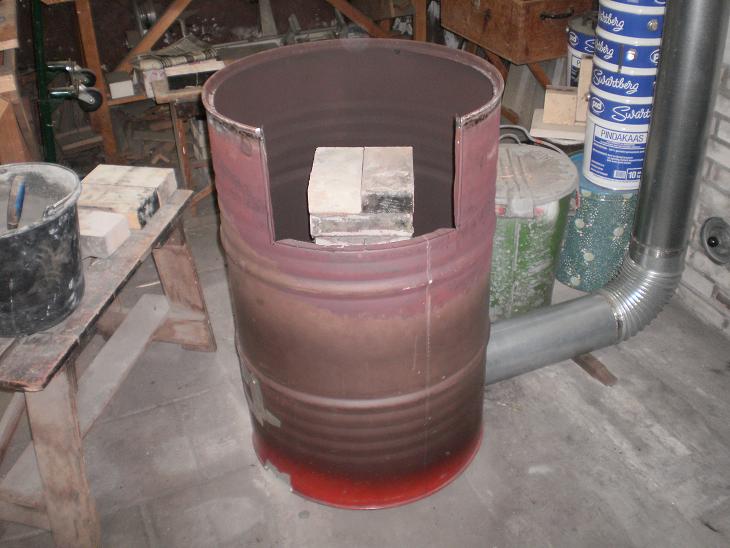 The opening in the bottom is slightly larger than the brick column and is made airtight with superwool. In front there's a third cutout, slightly wider than the firebox casting and half the height of it. Some flanges will make it easier to stuff the superwool in. Outside the barrel there's another column, one brick per layer and a concrete paver on top. Mark, the level of both the inside and outside columns are about 1/2" higher than the horizontal flange. 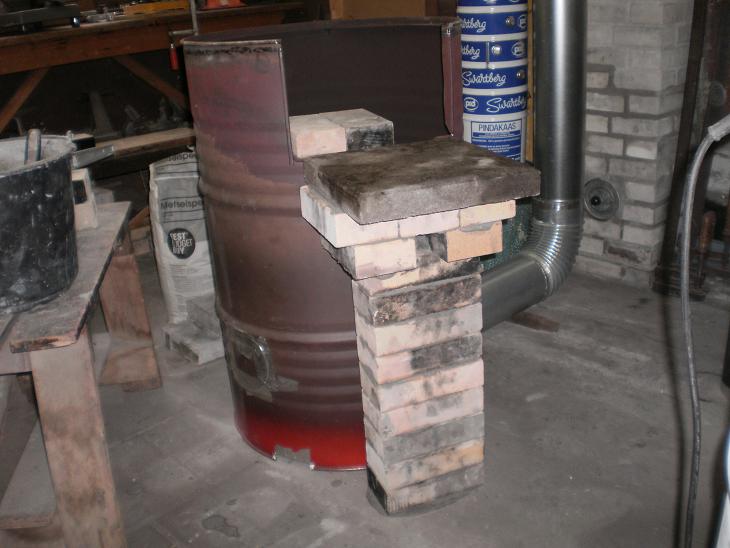 The first final firebox casting happened to be made in one piece, that's not to be repeated. The whole casting is cracked in 4 pieces, the bottom piece is in the picture, the largest chunk. 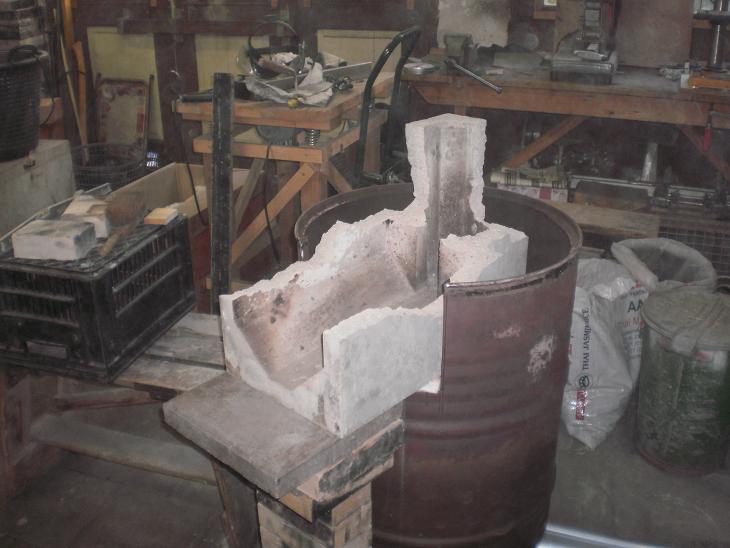 This is resting on the inside and outside columns, compressing the 1" superwool between the horizontal flange and the refractory. The cracks were thoroughly cleaned and wetted with a sand/clay slip, puzzled together and washed in with the same slip using a sponge. The p-channel was fitted and again, the crevices around the firebox were stuffed with superwool. 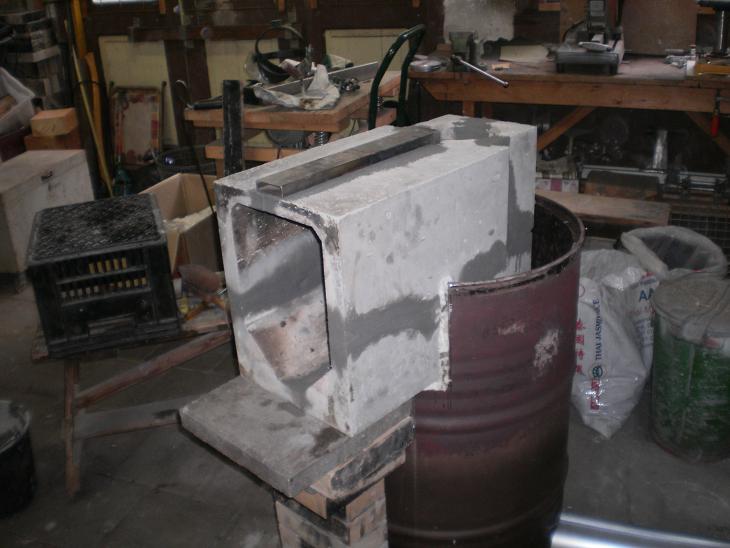 The next step was preparing the second barrel, top and bottom cut out except for a ridge of about 3/4" to retain stability of the circle. And a cut-out in front in order to create space for the firebox. 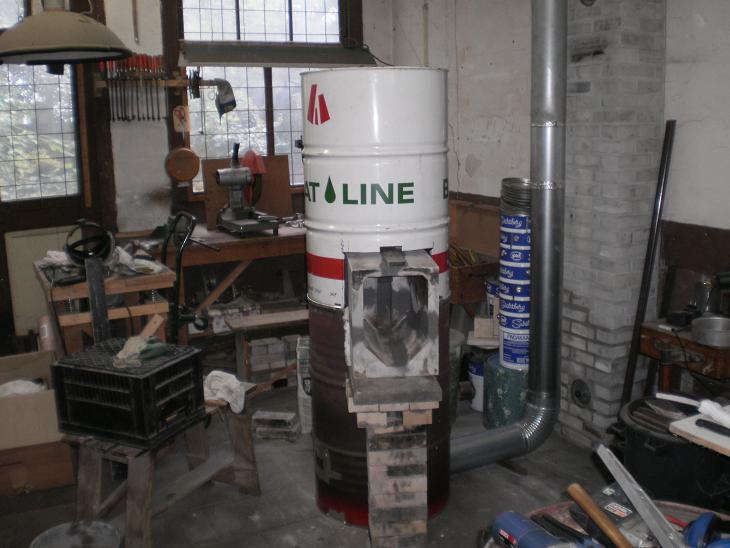 It's looking like a stove already but we are not there yet. The riser on top of the firebox is about 2' long, made of vacuum formed superwool and a heat resistant binder. Sadly, I don't have a picture of that. I don't know whether this would hold against the 2200 F. temperatures, in this respect this is another experiment. 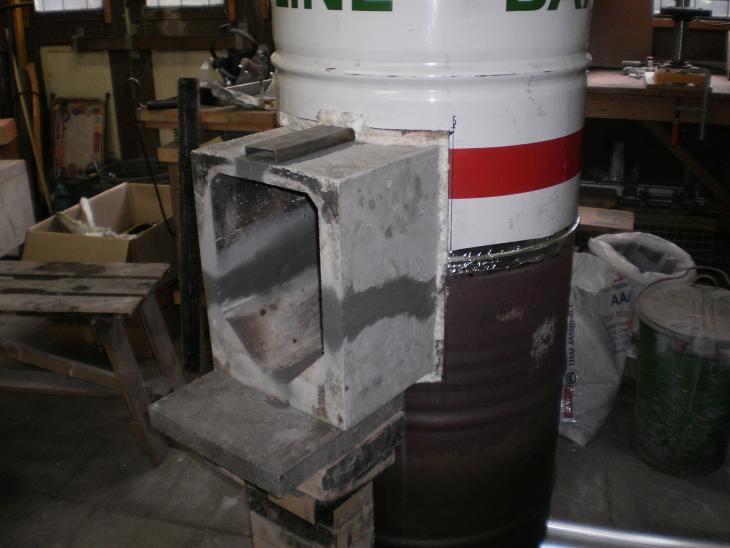 Here's another picture of the crevice around the firebox. The ridges of the barrels are fixed upon each other by means of aluminum tape. I know, this won't hold forever but it's in plain sight so I could renew it when need arise. And here's the complete stove, assembly is done. 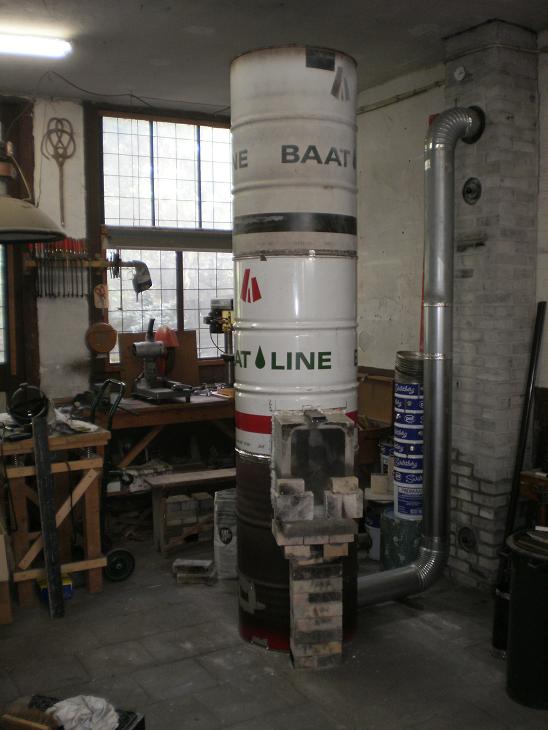 All the fittings are there, even the stove pipe is connected to the chimney. Nothing much to tell about, the stove is a bit slower to come to speed. The efficiency is permanently above 90%, end temps are 120 C (248 F), side of the barrel close to the top rim 300 C (572 F). This is at full bore only, when used in a more moderate fashion it will be 80 C and 240 C (175 F and 446 F) respectively.  Main inlet has to be larger, about 50 cm2 (7.75 sq in.) end temp shouldn't be lower than this 80 C, otherwise the afterburner will pop on and off. I'm ready for the coming winter now! This stove as it is, seems to be too large for a normal living space. So I would say, scale this down to a 5" or even a 4" system, use smaller barrels and you've got a quick heater. Of course, this isn't a mass heater but it do show the possibilities of such a system. This layout could be built out of brick and fire brick as well. It's really dead simple, only one bell and the batch rocket half inside and half outside. |
|
dvawolk
Full Member
   DSR2 125mm open system (actual project)
DSR2 125mm open system (actual project)
Posts: 271
|
Post by dvawolk on Oct 7, 2013 23:11:57 GMT -8
That is nice and clean! A school example!
If i compare this one with the option of batchbox being at the floor level, then this one needs some more draft from the chimney for the proper operation...
|
|
|
|
Post by peterberg on Oct 8, 2013 8:12:54 GMT -8
Klemen,
Yes that's true. This is done for conveniency, to build it and to use it. The distance to the floor is about 60 cm (2').
|
|
|
|
Post by matthewwalker on Oct 8, 2013 9:24:24 GMT -8
Thanks for sharing that Peter. You are getting very good numbers, which is encouraging since I'm using a similar riser of the same length. I have been wondering if there's any difference when I add the additional few inches to make it match the numbers in the spreadsheet of the base calculations. I haven't been able to discern any performance difference between the 24" riser and one that was extended by 6".
My one piece castings hold up about as well as yours, that is, not very. Doesn't matter much if you encase it in something and keep it together, but not much fun when you want to move it. They sure are easy to cast that way though.
|
|